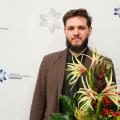Naujienos ir renginiai
- Titulinis
- Naujienos ir renginiai
- Naujienos
Naujienos
2023. 03. 22
-
Lithuanian professor has published a book that is read worldwide
Prof. Dr. habil. Eimutis Juzeliūnas is a world-known electrochemist, Lithuanian Science Prize (awarded by the Lithuanian Academy of Sciences) laureate, who is today working at the Center for Physical Sciences and Technology (FTMC). He published a book at the end of November 2022, which not only enriches the scientific community's knowledge of silicon, but also promotes Lithuania in foreign countries.
The book is a monograph "Silicon: Electrochemistry, Production, Purification and Applications", written in English and published by the US company Viley-VCH. This is truly remarkable: there are only a few monographs on silicon electrochemistry in the world and the last one was written 20 years ago.
The Lithuanian professor has thus added another signature to the history of electrochemical science.

(Prof. Eimutis Juzeliūnas. Photo: Dr. Domas Jokubauskis / FTMC)
But first, let's agree on the terms. Most of us have heard of Silicon Valley, a region in the USA that is home to thousands of IT companies such as Apple, Meta, Google and others. The Valley is so named because it was originally home to silicon chip makers, which have now been joined by a wide range of high-tech companies.
Silicon is the second most abundant element on the planet, accounting for about 28% of the Earth's crust. It is a tough, shiny, bluish-grey element also known as a semi-metal or metalloid. It occurs naturally in quartz (sand) or silicate minerals.
"Historians describe the stages of civilisation in terms of the materials that dominated production at the time and divide them into the Stone, Bronze or Iron Ages," says prof. Juzeliūnas. - The current period is called the Silicon Age.
This name is due to the unique role of silicon in the world economy. The material is essential in information technology devices, the semiconductor industry and electronics. Market analysts say that silicon will remain the dominant material in solar energy for at least several decades. Silicon is also used in the production of metal alloys, silicon organic compounds, fiber optics, ceramics, current sources, etc."

(Silicon nanostructure, magnified thousands of times. 1 micron (micrometer), "μm", is one thousandth of a millimetre. Photo: Prof. Eimutis Juzeliūnas / FTMC)
Meanwhile, electrochemistry, which FTMC expert is developing, is a field of science that studies the relationship between electricity and chemical transformations. According to prof. Juzeliunas, electrochemistry is mainly applied to sources of electric current, without which we could not imagine life today. We use these sources every day and in abundance - in home appliances, computers, cars and electric vehicles. Electricity generated by wind or the sun is stored in electrochemical storage devices.
"Any living organism also has an electrochemical structure: cell membranes, electrical impulses, the activity of the heart or the brain are all electrochemical objects. A ship at sea is also an electrochemical object. Its corrosion (rusting) is caused by electrochemical reactions. The same applies to rusting cars, bridges or power lines," says scientist.
Now let's talk about the main topic - the professor's book.

(Photo: Dr. Domas Jokubauskis / FTMC)
What is the significance of your new book? Is it being read and used by scientists all over the world?
Silicon electrochemistry has been a dynamically developing field in recent decades, primarily because of its outstanding importance for the development of sustainable energy technologies. However, there has been a lack of a broader, panoramic study of the development and potential of this field.
My monograph attempts to fill this gap. I wanted the book to be useful to a broad community: scientists, PhD students, students, technologists. The primary audience for the book is the community of chemists and materials scientists interested in the electrochemistry, production, purification and applications of silicon. The book is aimed at professionals who are interested in solar energy, the production of high-purity silicon, and the conversion of light energy into chemical bonds through batteries or photoelectrodes.
The secondary market for the book is educational and social groups such as students, PhD students or those interested in climate change reducing policies. These areas are global and do not fit into national frameworks. However, I believe that the book will also be of interest to a Lithuanian audience, in particular research centers, universities, colleges or technology companies.
It seems that the appearance of your book is quite a prestige for Lithuanian science.
This monograph will contribute to Lithuania's promotion in the world, will help to improve our country's image and will remind us that Lithuania is conducting high-level scientific research.
It is important that this message spreads not only in the academic community but also more widely.

(Prof. Eimutis Juzeliūnas. Photo: Dr. Domas Jokubauskis / FTMC)
We often hear about 'prestigious journals' and 'prestigious publishing houses'. To give us an idea, what kind of prestige has Wiley-VCH, which published your monograph, earned?
There is no single system for evaluating scientific publishers. Such evaluations are often based on the subjective opinion of the scientific community.
Wiley-VCH (John Wiley and Sons, Inc.) is an international US publishing house founded in 1807 in New York, specializing in books, journals and encyclopedias. In general, the company has a very high reputation, as any professional interested in the development of the physical sciences can attest.
Wiley-VCH is also the largest society publisher in the world. Its revenues have grown steadily in recent decades, reaching USD 2.08 billion in 2022. Naturally, the company's products are distributed worldwide.
The book was prompted by a well-received publication in the scientific world by you and the British chemist prof. Derek J. Fray on the electrochemistry of silicon in molten salts. The article was published in the journal Chemical Reviews. Could you tell us what the essence of this publication and research is, and how it could be interesting and important for all of us?
And again, what is the level of international influence of this journal?
Our collaboration with researchers at the University of Cambridge started after prof. D. J. Fray and I won two grants from the European Commission to carry out research on silicon electrochemistry. We have patented the results and also published them.
Our large-scale study was published in the journal Chemical Reviews and was like a prototype for a book. This journal carefully selects the most relevant topics and pays particular attention to critical analysis, challenges and perspectives in the field of science it covers.
The journal has a particularly high Impact Factor (IF). According to the Clarivate Journal Citation Reports database, Chemical Reviews had an IF of 72.1 in 2021. This is one of the highest rates among natural science journals (compare other elite journals: Nature, 69.5; Science, 63.8).
Electrochemists usually carry out their studies in aqueous solutions. However, the electrochemical extraction of silicon from such solutions is problematic because it requires higher energy than can be provided in aqueous solutions using an electric current. In addition, at room temperature, pure silicon is a poor conductor of electricity and is therefore difficult to isolate under such conditions.
Our studies were carried out in molten salts at temperatures of almost a thousand degrees. This has led to important surface structures such as black silicon. We have reviewed these and other patterns in the article in Chemical Reviews.

(Silicon nanostructure, magnified thousands of times. 1 micron (micrometer), "μm", is one thousandth of a millimetre. Photo: Prof. Eimutis Juzeliūnas / FTMC)
You have developed a technology for producing black silicon from molten salts, which has been patented in Europe, UK, USA, China, Brazil and Japan. What is this technology and how does it serve science and society?
Black silicon is a material that has almost 100% light absorption, thus increasing light conversion efficiency. At the same time, untreated silicon reflects only more than a third of the light; in other words, a large part of the light energy in photovoltaic installations remains unused.
Black silicon is also promising for hydrogen energy, extracting hydrogen from water by light.
Various physico-chemical technologies for the formation of black silicon are used in laboratories for scientific purposes, but they are technically complex, therefore expensive and have limited practical applications. In addition, some of the technologies use toxic, aggressive (disruptive) materials and expensive precious metal catalysts. Our proposed electrochemical method for the formation of black silicon is environmentally friendly and economical.
It is sufficient to place a silicon blank with a layer of silicon oxide in molten salt and to apply a fixed electrical voltage to it. At high temperatures (around 800 °C), the silicon is released from the oxide, the reaction spreads over the surface and forms various architectures, also known as nano-structures. Calcium chloride is commonly used as a melt, as it is cheap, non-toxic and highly soluble in water, making it easy to remove the residue from the silicon structure formed.
.png)
(Prof. Eimutis Juzeliūnas. Photo: Dr. Domas Jokubauskis / FTMC)
You are currently exploring how to use silicon to improve solar cells. What new discoveries have been made in this field?
As I mentioned, our previous research has been carried out at high temperatures of up to a thousand degrees. We are currently working on initiating and controlling electrochemical processes in silicon at room temperature. This is very important from an economic-energy point of view; lower temperatures mean lower energy consumption, simpler equipment, cheaper materials.
Our research is supported by a grant from Lithuanian Academy of Sciences called "New silicon structures for efficient photoelectrochemistry". We have obtained interesting results which we hope to report in the near future.
Susiję:

2023. 12. 04
-
Contribution to green energy: a chemist, who extracts hydrogen, P. Gaigalas defends his PhD
Platinum is so far the best choice for water splitting. But this metal is rare and expensive, so scientists are looking for other ways.

2023. 09. 15
-
Physicist interested in black silicon L. Golubewa becomes the new PhD in Natural Sciences
Desired technology sounds like something out of science fiction - but science is moving towards it, and Lena is contributing to it too.

2023. 07. 27
-
PhD student has developed a sensor that promises a breakthrough in the food industry
Vytautas Žutautas never thought he would ever do chemistry in his life. But suddenly he discovered his own way in this field.
-d3ebffb4068447faacd857efd4752836.jpg)
a-1c4665da2983c54a69676278eaef7e7e-4933f45149f496562be400e3b866708b.jpg)